Market Size of Global Viral Inactivation Industry

| Study Period | 2019 - 2029 |
| Base Year For Estimation | 2023 |
| CAGR | 12.50 % |
| Fastest Growing Market | Asia Pacific |
| Largest Market | North America |
| Market Concentration | Medium |
Major Players
*Disclaimer: Major Players sorted in no particular order |
Viral Inactivation Market Analysis
The viral inactivation market is poised to grow at a CAGR of 12.5 % over the forecast period.
The outbreak of COVID-19 has turned the spotlight on the studied market as most of the biopharmaceutical players are involved in the development of novel therapeutics against the SARS-CoV2 virus. However, the research and development activities of non-COVID-19 drugs have slowed down due to the stringent guidelines by the regulatory authorities during the pandemic. According to a study that was published in the American Chemical Society Pharmacology and Translational Science, 2020, new potential therapeutics for COVID-19 that were discovered using a combined virtual and experimental screening strategy and chosen from among the medications that were already in use were examined to check for structural similarity against a library of almost 4000 medications that were already in use, with hydroxychloroquine (HCQ) serving as a reference medication. The study suggested remdesivir and favipiravir therapies as prospective adjuvants in COVID-19 treatment as well as zuclopenthixol, nebivolol, and amodiaquine as potential candidates for clinical trials against the early phase of the SARS-CoV-2 infection. Additionally, more than 1000 clinical trials are currently being conducted to repurpose FDA-approved medications and evaluate the safety and efficacy of investigational antiviral compounds in the fight against COVID-19, according to the study Drug Discovery of Small Molecules for the Treatment of COVID-19: A Review on Clinical Studies in 2021. This review concentrates on the potential of currently available FDA-approved medications and molecules that are in the clinical pipeline to treat viral infections like HIV, hepatitis B, Ebola virus, and other coronavirus family viruses because new medications can take months to years to develop and reach the market (SARS-CoV and MERS-CoV). Thus, the market was adversely affected by the pandemic.
The major factors attributing to the growth of the viral inactivation market are a rise in the global prevalence of chronic diseases like cancer, autoimmune disorders, and other diseases along with an increase in healthcare expenditure. Globocan 2020 reported that in 2020, the 5-year prevalence of all types of cancers in both sexes is 2,166,740 in Africa. It has also been reported that out of these cases, 1,298,101 cases were reported in females and 868,639 cases were reported in males of all ages. Such a large prevalence of cancer is driving the growth of the market over the forecast period. Additionally, the same source also reported the 5-year prevalence of cancer cases in Saudi Arabia there are about 82,640 cases of all types of cancer in both sexes and out of which 39,241 cases were reported in males and 43,399 cases in females in 2020. Rising approvals from Food and Drug applications for drug candidates are also expected to drive the growth of the studied market. For instance, according to the data published on Mid-Year Review: New Drug Approvals in June 2021, the United States Food and Drug Administration's (FDA) Center for Drug Evaluation and Research (CDER) has authorized 26 New Molecular Entity's (NMEs) at the halfway point of 2021 (as of June 28, 2021), which was on par with the full-year 2020 approval rate of 53 NMEs. Except for 2018, when 59 NMEs were granted, the number of NMEs approved in 2020 was the second most in the last decade. The rising approvals from FDA will further boost the research and development activities, which will in turn need toxicology screening studies which are expected to increase the adoption of viral inactivation technologies, thereby expected to propel the growth of this market. Thus, the above-mentioned factors are expected to increase market growth.
Viral Inactivation Industry Segmentation
As per the scope of the report, viral inactivation is a method of viral processing, where the final product may contain the viruses in an inactive form. The Virus inactivation process is a critical step in process development for biologicals such as tissue and tissue products, stem cell products, and vaccines, and therapeutics. The viral inactivation market is segmented by method (solvent detergent method, ph adjustment method, pasteurization, and others), product (viral inactivation systems and accessories, kits and reagents, and others), application (vaccines and therapeutics, blood & blood products, cellular & gene therapy products, and others), end-user (pharmaceutical and biotechnology companies, contract research organisations, and others), and geography (North America, Europe, Asia-Pacific, Middle-East and Africa, and South America). The market report also covers the estimated market sizes and trends for 17 different countries across the major regions globally. The report offers the values (USD million) for the above segments.
| By Method | |
| Solvent Detergent Method | |
| pH Adjustment Method | |
| Pasteurization | |
| Others |
| By Product | |
| Viral Inactivation Systems and Accessories | |
| Kits and Reagents | |
| Others |
| By Application | |
| Vaccines and Therapeutics | |
| Blood & Blood Products | |
| Cellular & Gene Therapy Products | |
| Others |
| By End User | |
| Pharmaceutical and Biotechnology Companies | |
| Contract Research Organisations | |
| Others |
| Geography | ||||||||
| ||||||||
| ||||||||
| ||||||||
| ||||||||
|
Global Viral Inactivation Market Size Summary
The viral inactivation market is experiencing significant growth, driven by the increasing global prevalence of chronic diseases such as cancer and autoimmune disorders, alongside rising healthcare expenditures. The COVID-19 pandemic has highlighted the importance of viral inactivation technologies, as biopharmaceutical companies focused on developing therapeutics against SARS-CoV-2, although this also led to a temporary slowdown in the research and development of non-COVID-19 drugs due to stringent regulatory guidelines. The market is expected to expand as more FDA-approved medications are repurposed and investigated for their efficacy against various viral infections, including HIV, hepatitis B, and Ebola. The vaccines and therapeutics segment is anticipated to dominate the market, fueled by the high incidence of chronic diseases and substantial government support for pharmaceutical and biotechnology research and development.
North America is projected to lead the viral inactivation market, with the United States playing a pivotal role due to its advanced healthcare infrastructure and significant investment in healthcare research and development. The presence of major pharmaceutical and biopharmaceutical companies further bolsters the market in this region. Canada and Mexico are also contributing to market growth through robust research and development pipelines and strategic pharmaceutical policies. The market is moderately consolidated, with major players like Cytiva, Merck KGaA, and Sartorius AG dominating through strategic acquisitions and mergers. Continuous technological innovations and the entry of new players with innovative product pipelines are expected to further enhance market revenue over the forecast period.
Global Viral Inactivation Market Size - Table of Contents
-
1. MARKET DYNAMICS
-
1.1 Market Overview
-
1.2 Market Drivers
-
1.2.1 Rapid Growth in Pharmaceutical and Biotechnology Industries and Strong R&D Investments
-
1.2.2 Increasing Number of New Drug Launches with Increased Government Support
-
-
1.3 Market Restraints
-
1.3.1 Highly Expensive Manufacturing Processes of Biosimilars
-
1.3.2 Complex Regulatory Framework for Validation of Inactivated Products
-
-
1.4 Porter's Five Force Analysis
-
1.4.1 Threat of New Entrants
-
1.4.2 Bargaining Power of Buyers/Consumers
-
1.4.3 Bargaining Power of Suppliers
-
1.4.4 Threat of Substitute Products
-
1.4.5 Intensity of Competitive Rivalry
-
-
-
2. MARKET SEGMENTATION (Market Size by Value - USD million)
-
2.1 By Method
-
2.1.1 Solvent Detergent Method
-
2.1.2 pH Adjustment Method
-
2.1.3 Pasteurization
-
2.1.4 Others
-
-
2.2 By Product
-
2.2.1 Viral Inactivation Systems and Accessories
-
2.2.2 Kits and Reagents
-
2.2.3 Others
-
-
2.3 By Application
-
2.3.1 Vaccines and Therapeutics
-
2.3.2 Blood & Blood Products
-
2.3.3 Cellular & Gene Therapy Products
-
2.3.4 Others
-
-
2.4 By End User
-
2.4.1 Pharmaceutical and Biotechnology Companies
-
2.4.2 Contract Research Organisations
-
2.4.3 Others
-
-
2.5 Geography
-
2.5.1 North America
-
2.5.1.1 United States
-
2.5.1.2 Canada
-
2.5.1.3 Mexico
-
-
2.5.2 Europe
-
2.5.2.1 Germany
-
2.5.2.2 United Kingdom
-
2.5.2.3 France
-
2.5.2.4 Italy
-
2.5.2.5 Spain
-
2.5.2.6 Rest of Europe
-
-
2.5.3 Asia-Pacific
-
2.5.3.1 China
-
2.5.3.2 Japan
-
2.5.3.3 India
-
2.5.3.4 Australia
-
2.5.3.5 South Korea
-
2.5.3.6 Rest of Asia-Pacific
-
-
2.5.4 Middle-East and Africa
-
2.5.4.1 GCC
-
2.5.4.2 South Africa
-
2.5.4.3 Rest of Middle-East and Africa
-
-
2.5.5 South America
-
2.5.5.1 Brazil
-
2.5.5.2 Argentina
-
2.5.5.3 Rest of South America
-
-
-
Global Viral Inactivation Market Size FAQs
What is the current Global Viral Inactivation Market size?
The Global Viral Inactivation Market is projected to register a CAGR of greater than 12.5% during the forecast period (2024-2029)
Who are the key players in Global Viral Inactivation Market?
Merck KGaA, Sartorius AG, Texcell SA, Cytiva (Danaher Corporation) and Parker Hannifin Corp are the major companies operating in the Global Viral Inactivation Market.

